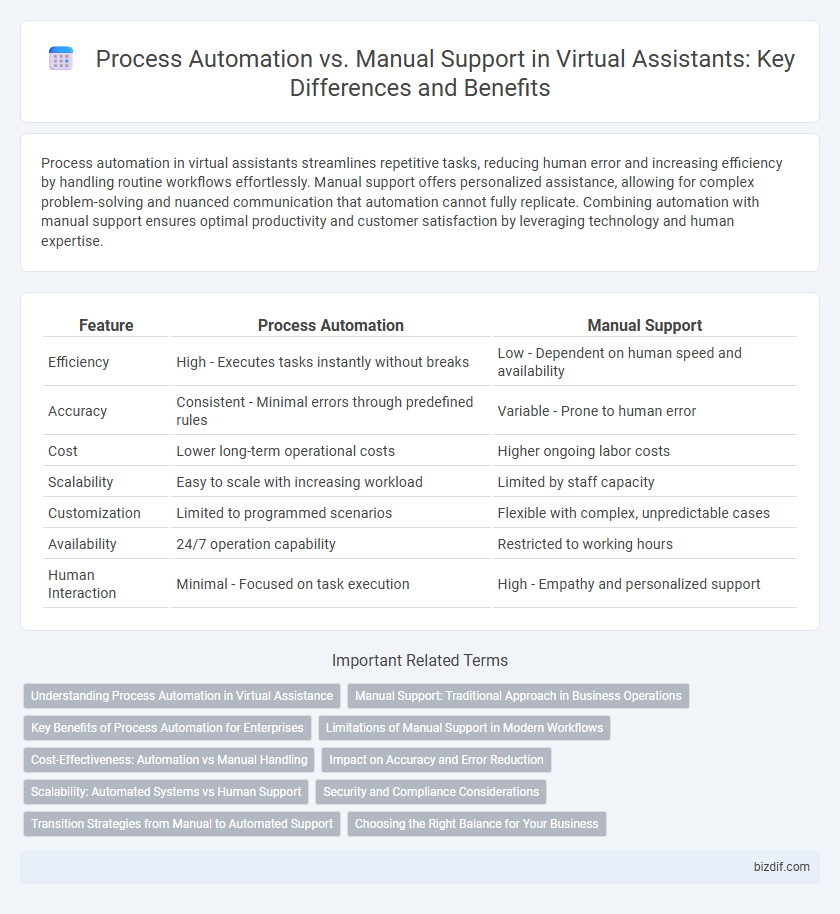Process automation in virtual assistants streamlines repetitive tasks, reducing human error and increasing efficiency by handling routine workflows effortlessly. Manual support offers personalized assistance, allowing for complex problem-solving and nuanced communication that automation cannot fully replicate. Combining automation with manual support ensures optimal productivity and customer satisfaction by leveraging technology and human expertise.
Table of Comparison
| Feature | Process Automation | Manual Support |
|---|---|---|
| Efficiency | High - Executes tasks instantly without breaks | Low - Dependent on human speed and availability |
| Accuracy | Consistent - Minimal errors through predefined rules | Variable - Prone to human error |
| Cost | Lower long-term operational costs | Higher ongoing labor costs |
| Scalability | Easy to scale with increasing workload | Limited by staff capacity |
| Customization | Limited to programmed scenarios | Flexible with complex, unpredictable cases |
| Availability | 24/7 operation capability | Restricted to working hours |
| Human Interaction | Minimal - Focused on task execution | High - Empathy and personalized support |
Understanding Process Automation in Virtual Assistance
Process automation in virtual assistance streamlines repetitive tasks by leveraging AI-driven tools and software, significantly increasing efficiency and reducing human error. Unlike manual support, which relies on human intervention for each task, process automation handles workflows such as scheduling, data entry, and customer queries autonomously. This transformation enables virtual assistants to deliver faster responses, consistent service quality, and allows human agents to focus on complex problem-solving and personalized interactions.
Manual Support: Traditional Approach in Business Operations
Manual support in business operations relies on human intervention to perform tasks, ensuring personalized attention and adaptability to complex scenarios. This traditional approach often involves higher labor costs, increased error rates, and slower response times compared to process automation. Despite these drawbacks, manual support remains essential for handling unique cases, customer empathy, and decisions requiring nuanced judgment beyond automated system capabilities.
Key Benefits of Process Automation for Enterprises
Process automation significantly increases efficiency by reducing manual errors and streamlining repetitive tasks, enabling enterprises to allocate resources more strategically. It enhances scalability, allowing businesses to handle higher volumes of operations without proportional increases in labor costs. Automated workflows improve consistency and compliance, ensuring that processes adhere to regulatory standards and internal policies.
Limitations of Manual Support in Modern Workflows
Manual support in modern workflows often struggles with inefficiency due to repetitive tasks and high error rates, leading to decreased productivity. It lacks scalability, making it difficult to handle increased workloads and complex processes consistently. Human limitations in speed and accuracy hinder timely decision-making and negatively impact overall operational performance.
Cost-Effectiveness: Automation vs Manual Handling
Process automation in virtual assistants significantly reduces operational costs by minimizing human labor and increasing task efficiency. Manual support requires continuous staffing, resulting in higher salaries, training expenses, and susceptibility to human error. Automated systems deliver consistent performance with lower overhead, optimizing cost-effectiveness in handling repetitive and scalable tasks.
Impact on Accuracy and Error Reduction
Virtual assistants significantly enhance process automation by minimizing human intervention, leading to higher accuracy and substantial error reduction in task execution. Automated workflows powered by AI reduce inconsistencies common in manual support, ensuring data integrity and faster problem resolution. This shift from manual to automated processes drives improved operational efficiency and decreases costly mistakes.
Scalability: Automated Systems vs Human Support
Automated systems enable seamless scalability by handling increasing volumes of tasks without proportional increases in resource costs, unlike manual human support which encounters limitations in workforce availability and efficiency. Virtual assistants powered by AI can manage numerous interactions simultaneously, ensuring consistent performance regardless of demand spikes. This scalability advantage allows businesses to expand operations rapidly while maintaining cost-effectiveness and service quality.
Security and Compliance Considerations
Process automation in virtual assistants significantly enhances security by minimizing human error and ensuring consistent adherence to compliance protocols such as GDPR and HIPAA. Automated workflows enable real-time monitoring, encrypted data handling, and audit trails, which are critical for regulatory requirements and risk management. Manual support, while flexible, often introduces vulnerabilities through inconsistent access controls and potential data mishandling, posing higher compliance risks.
Transition Strategies from Manual to Automated Support
Transitioning from manual support to process automation requires a strategic approach that includes detailed workflow analysis and stakeholder training to ensure smooth adoption. Leveraging robotic process automation (RPA) and AI-driven chatbots can significantly reduce human error and increase efficiency during the transition phase. Continuous monitoring and iterative improvements are essential to address workflow bottlenecks and optimize the automated support system for sustained performance.
Choosing the Right Balance for Your Business
Effective process automation streamlines repetitive tasks, reducing errors and operational costs while enhancing efficiency across customer support and administrative workflows. Manual support remains essential for handling complex queries, personalized interactions, and nuanced decision-making that require human empathy and judgment. Striking the right balance involves assessing customer needs, task complexity, and scalability to optimize resource allocation and deliver superior service outcomes.
Process automation vs Manual support Infographic

 bizdif.com
bizdif.com